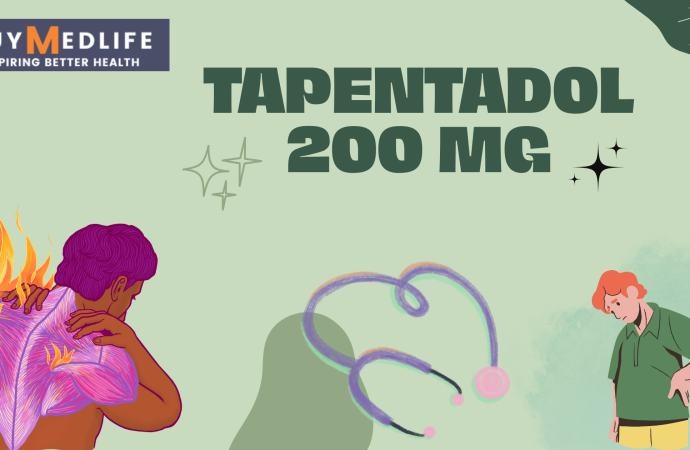Pain is a universal human experience, but not all pain is the same — nor is every treatment. If you’re living with moderate to severe pain, especially from nerve damage, injuries, or chronic conditions, you may have heard of Tapentadol 200 mg. This potent analgesic has gained attention for offering strong pain relief with a
Pain is a universal human experience, but not all pain is the same — nor is every treatment. If you’re living with moderate to severe pain, especially from nerve damage, injuries, or chronic conditions, you may have heard of Tapentadol 200 mg. This potent analgesic has gained attention for offering strong pain relief with a dual-action mechanism.
But the question remains: Is Tapentadol 200 mg the right choice for your pain? In this blog, we’ll explore what Tapentadol is, how it works, who should (and shouldn’t) take it, and what to consider before starting this medication.
What Is Tapentadol 200 mg?
Tapentadol is a centrally acting opioid analgesic used to treat moderate to severe pain. It is available in both immediate-release (IR) and extended-release (ER) formulations. The 200 mg dose is typically prescribed for chronic, ongoing pain conditions that have not responded well to milder painkillers.
Tapentadol stands out because it works through two mechanisms:
-
Mu-opioid receptor agonist—It binds to opioid receptors in the brain to block pain signals.
-
Norepinephrine reuptake inhibitor (NRI) – It enhances norepinephrine activity to interrupt pain transmission.
This combination allows Tapentadol to relieve both nociceptive (physical injury) and neuropathic (nerve-related) pain.
Who Can Benefit from Tapentadol 200 mg?
Tapentadol 200 mg is not a first-line pain medication. It is reserved for people who:
-
Suffer from chronic musculoskeletal pain
-
Experience severe neuropathic pain, such as diabetic neuropathy
-
Have tried other painkillers (NSAIDs, weaker opioids) with little relief
-
Require long-term pain management
-
Need a stronger yet more tolerable alternative to morphine or oxycodone
Common Conditions Treated:
-
Lower back pain
-
Cancer pain
-
Post-surgical pain
-
Osteoarthritis
-
Fibromyalgia (in select cases)
-
Sciatica or pinched nerves
How Effective Is Tapentadol 200 mg?
Clinical studies have shown that Tapentadol is equally effective as oxycodone but often better tolerated. Patients report less nausea, constipation, and sedation compared to traditional opioids.
In neuropathic pain, its unique NRI action gives it an edge over other opioids that don’t target nerve pain.
Benefits of Tapentadol:
-
Dual pain-relief action
-
Fast onset (within 30-60 minutes)
-
Long-lasting relief (especially with extended-release)
-
Lower risk of gastrointestinal side effects
Is It Safe? Understanding Side Effects
Like all opioids, Tapentadol 200 mg comes with risks, especially at high doses. It is not meant for short-term use or minor aches. Safety depends on correct use, medical supervision, and individual health factors.
Common Side Effects:
-
Nausea and vomiting
-
Dizziness or light-headedness
-
Constipation
-
Drowsiness
-
Dry mouth
-
Headache
Serious Risks:
-
Respiratory depression (slowed breathing)
-
Dependence and addiction
-
Serotonin syndrome (when mixed with SSRIs)
-
Seizures (rare)
-
Liver or kidney issues (in susceptible patients)
It’s crucial to never combine Tapentadol with alcohol, sedatives, or other opioids without a doctor’s approval.
Who Should Avoid Tapentadol 200 mg?
Tapentadol is not suitable for everyone. You should avoid or use with caution if you have:
-
A history of opioid abuse or addiction
-
Breathing disorders (e.g., sleep apnea, asthma)
-
Severe liver or kidney disease
-
Head injuries or brain disorders
-
Are pregnant or breastfeeding
-
Are taking antidepressants or other serotonin-modifying drugs
Always disclose your full medical history to your doctor before starting Tapentadol.
How to Take Tapentadol 200 mg Safely
1. Follow Prescribed Dosage
Do not increase your dose or take it more frequently than advised. Doing so increases the risk of addiction and overdose.
2. Swallow Whole
Do not crush or chew the tablet—especially extended-release—as it can lead to a dangerous release of the full dose.
3. Stay Hydrated & Monitor for Side Effects
Drink water, track bowel movements, and inform your doctor of any unusual reactions.
4. Avoid Driving or Heavy Machinery Initially
Tapentadol may impair your ability to stay alert.
Tapentadol vs Other Pain Medications
| Medication | Type | Strength | Key Feature |
|---|---|---|---|
| Tapentadol | Opioid + NRI | Strong | Works on nerve & injury pain |
| Tramadol | Weak opioid + SNRI | Moderate | Milder but less effective |
| Oxycodone | Pure opioid | Very Strong | More risk of side effects |
| Ibuprofen | NSAID | Mild | Better for inflammation |
| Pregabalin | Anticonvulsant | Moderate | Designed for nerve pain |
Tapentadol 200 mg often falls between tramadol and oxycodone in terms of strength and side effect profile, making it a balanced choice for long-term moderate to severe pain.
Is Tapentadol 200 mg Addictive?
Yes, Tapentadol has abuse potential, especially when taken in high doses or for extended periods. However, when used responsibly under medical supervision, it has a lower risk of dependence than some stronger opioids.
Watch for signs of tolerance or cravings, and never stop abruptly—tapering under a doctor’s care is essential to avoid withdrawal symptoms.
Final Thoughts
Tapentadol 200 mg can be a lifesaver for individuals living with intense, persistent pain that interferes with daily life. Its dual-action mechanism offers broad relief, especially when nerve pain is involved. However, it’s not without risks, and choosing Tapentadol must involve a careful evaluation of your condition, history, and alternative treatments.
Talk to your doctor if:
-
Your current pain medications aren’t working
-
You experience both nerve and physical pain
-
You are seeking a strong option with fewer GI side effects
When taken with care, Tapentadol 200 mg can greatly improve quality of life for many pain sufferers.
















